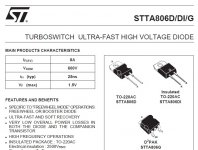They have lower Vgs for same current level, so less resistance is need to set proper bias. This also affects gain structure.
Correct: My IRFP9240 / 240's in normal F5 have Vgs around 4,5 volts and 1K Ohm fits. The 2sj201/1530 are around 2,5 volts, so 475 Ohm fits.
I agree - both the best and the easiest wayJust add another resistor on the back till you find the value you need.
That way you can add and/or remove these extra paralleling resistors without risking any damage to the pads.
It must be Murphy's law that I always have to increase resistance and I just wish than sombody would brake the laws of physics and make a restistor that increases total resistance when used in paralell
Swell...
Another 4 resistors to remove from my Teabag boards and replace with these values.
Is it gonna have impact on sound?
You don't have to do anything. Those resistors are paralleled with P1 and P2 trimpots. Even better, once you set the bias where you like, remove P1/P2, measure and replace with equivalent resistors.
Is this diode suitable for F5 turbo ?
View attachment 355417
No, 8A not enough.
Here is a better option if you want ultra-fast.
STTH30R06CW STMicroelectronics | Mouser
But I think there are better options though. I see this one is not soft recovery.
STTH30R06CW STMicroelectronics | Mouser
But I think there are better options though. I see this one is not soft recovery.
Last edited:
This diode ISL9R3060P2 PDF Datasheet 30A, 600V, STEALTH? Diode have the amps you require, is soft recovery, 600V reverse voltage and is the single type. This might be just what you are looking for.
the existing fixed resistor and the Variable resistor are in parallel.You don't have to do anything. Those resistors are paralleled with P1 and P2 trimpots. Even better, once you set the bias where you like, remove P1/P2, measure and replace with equivalent resistors.
With Vr set to zero ohms, the voltage applied to the output stage is zero volts.
Adjusting Vr upwards increases the effective resistance of the parallel pair.
This increases the voltage applied across Vgs of the output device.
If the output device cannot be turned on sufficiently to reach the desired output stage bias current, then the PROBLEM is a too low resistance of the parallel combination.
That problem will NOT be solved by adding an extra parallel resistor on the back.
But the PROBLEM for Henry & Buzz and anyone else proposing to use the 201/15301 is quite different.
They are Low Vgs devices and requires a lower voltage and thus lower resistance of the resistor//Vr.
If Henry, or others, do not change the fixed resistor, either by changing to a lower value, or by adding an extra paralleling resistor then the Vr will have to be set to a very low value.
This is VERY bad for the reliability of the Vr.
I strenuously recommend my original suggestion in post2123.
Last edited:
Non repetitive peak current of 325Apk.
Do you really need one of these 30A devices for each output device?
Andrew, yes, I would strongly advise it for a 50 - 100W Class A amplifier. A diode that goes short-circuit is not good for the health of the amplifier. It is not that much more in cost, and more a case of better be safe than sorry.
Put it this way, that is what I would do, and what I have done for my KSA50 clone and my bridges run cool to the touch in the KSA50.
well. when the output devices can only handle 12-20A there is no reason for the diodes to have to handle 30A.
and this is not for the bridges. it is in parallell with the source resistors.
OK, maybe audiok must qualify if referal is made to the diodes parallel to the output devices or to the actual bridges in the PSU. If audiok refers to the diodes parallel to the output devices, then yes, I agree that 30A devices are not required and that 15A devices will be sufficient.
I suspect the repetitive peak capacity of 8A diodes is sufficient for the Source of each output device.
If an ordinary F5 using single devices were going into ClassAB, the current peak will be quite big and here a 16A device may be more suitable.
But all the F5 versions that use 2pair, or more, have generally lower current going through EACH output device and it's here that the 8A diode should be sufficient.
The peak non repetitive current of a MUR820 is 100Apk. A pair of these offer 200Apk output when used with a 2pair F5.
A 3pair F5 will have a non repetitive 300Apk capability using 8A diodes.
This is far in excess of what the mosFETs can pass.
If an ordinary F5 using single devices were going into ClassAB, the current peak will be quite big and here a 16A device may be more suitable.
But all the F5 versions that use 2pair, or more, have generally lower current going through EACH output device and it's here that the 8A diode should be sufficient.
The peak non repetitive current of a MUR820 is 100Apk. A pair of these offer 200Apk output when used with a 2pair F5.
A 3pair F5 will have a non repetitive 300Apk capability using 8A diodes.
This is far in excess of what the mosFETs can pass.
Last edited:
- Home
- Amplifiers
- Pass Labs
- F5 Turbo Builders Thread

